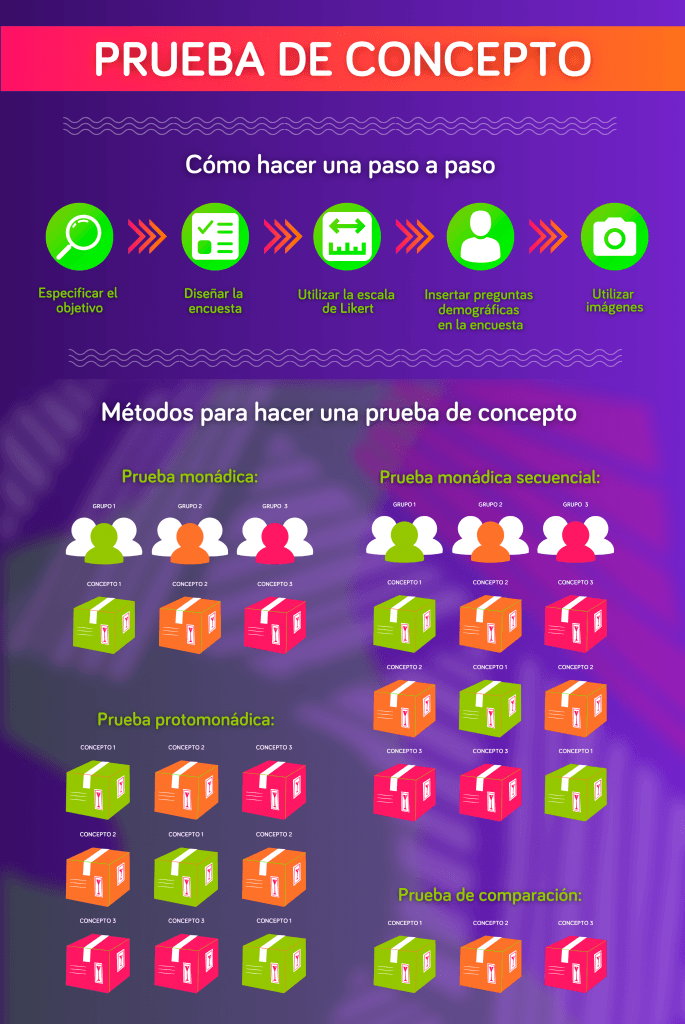
A proof of concept is a market research study that allows you to validate new product ideas with consumers or customers. Creating a new product requires a lot of effort and resources. But will all that effort result in success? Thanks to proof of concept tests, you can estimate the acceptance your product will have in the market.
In this article, we will provide you with all the details about the types of proof of concept and its most common variations: monadic, sequential monadic, comparative, and protomonadic proof of concept tests.
What is a Proof of Concept?
If you want the short answer, a proof of concept can be summarized as follows: a type of market research to determine if your potential customer will buy your product.
The key is the intention to purchase. You can have the best idea for a new product, but if no one wants to buy it, all the effort you put into it will be in vain. Thanks to this type of qualitative research, you can find out which ideas work and which ones need improvement with your audience.
Methods for Conducting a Proof of Concept
There are many different ways to conduct a proof of concept, depending on the information you want to obtain. Here are some of the most common ones.
Monadic Proof of Concept
If you want to thoroughly analyze various concepts in isolation, this is your method. Monadic proof of concept is conducted with different groups, and each group is asked questions about a single concept. This way, in addition to obtaining more information about each concept, results are obtained much faster.
Sequential Monadic Proof of Concept
It is very similar to monadic proof of concept, but in this test, all concepts are shown to all groups. With sequential monadic proof of concept, all concepts are put into perspective, and a smaller number of respondents is usually required.
Comparative Proof of Concept
If in monadic tests respondents are divided into groups, in comparative proof of concept, the opposite is done. As the name suggests, this test involves presenting multiple concepts, and respondents choose which one is the best. The good thing about this type of test is that the results are easy to understand, but be careful, they lack context.
Protomonadic Proof of Concept
This test is the result of the merger between sequential monadic proof of concept and comparative proof of concept. In this test, respondents are segmented again, and they are shown several concepts. As in the comparative test, they have to choose the best one. This type of concept test is usually used to check the results obtained in the sequential monadic test.
Applications of Proof of Concept
While it is true that proof of concept tests can be used to determine whether a future product will sell or not, they can also be used in other ways. For example, let’s say your company’s logo is a few years old, and you want to refresh it. Your team has several proposals, but you’re not sure which one to choose. Thanks to this qualitative research, you can find out what your target audience thinks, which is crucial for selecting the appropriate logo.
Do you want to give your website a facelift? Many times we are afraid to do so because users are accustomed to a design. Changing it doesn’t always mean an improvement, which is why we must use all the tools at our disposal to ensure that the change benefits the user. These tests can provide the customer knowledge that is so useful.
In summary, this form of market research is useful for anything related to your target audience.
How to Conduct a Proof of Concept Step by Step
Now that it’s clear what proof of concept tests are and the different types, it’s time to define the steps to follow.
First, as in any good strategy, you must specify the objective.
What do we want to achieve with this test? Knowing what we want to achieve will make it easier to formulate questions that will be useful to us.
This leads us to the next step: Designing the Survey. While knowing the objective is a great help in structuring the questionnaire, arranging the questions into different blocks also influences. At the beginning of the survey, simpler and more engaging questions are usually asked, and as it progresses, more complex questions (which are usually the ones we are most interested in) are asked.
While you are constructing the questionnaire, keep in mind that it is recommended to use the Likert scale in several questions. At both ends of this scale, phrases like «strongly agree» and «strongly disagree» are placed. Usually, 5 to 7 points are used, as this forces the respondent to lean towards one of the two options, even if only slightly. Keep in mind that consistency is very important; if you have placed «strongly agree» on the left in one question, maintain that position in the rest of the questions.
Continuing with the questions, it is also important to ask some demographic questions, especially at the beginning. On the one hand, they serve to break the ice (as mentioned earlier, asking easy questions at the beginning), and on the other hand, they help to better organize the data obtained in the survey.
Last but not least, use images in your concept test. They are very useful, especially if one of the concepts you want to analyze is visual. However, including an image from time to time can make the survey more engaging for the respondent.
Tips for Proof of Concept Tests
This type of market research is very useful for any service or product you want to bring to the market, among other things. At We Are Testers, we have several tools at your disposal, and all of them will help you: streamline the process, obtain reliable results, facilitate survey design and data management, and, in general, gain in-depth knowledge of your target audience.
These tools are very useful and will be of great help, but they also need to be used correctly. For example, as mentioned earlier, it is very important to be specific. This precision is not limited to the survey’s objective; it is equally important when selecting the target audience, asking what we want to know (in the right way) in the questionnaire, and so on.
When conducting the proof of concept survey, keep in mind that people, not robots, will be taking it. So, having some variety in the questionnaire is appreciated by many. Alternate between short-answer questions and scale questions, and try to insert some images from time to time.
Once you have the feedback, organize and analyze the data in a way that makes it easy to see which concept is the most promising.
Update date 29 December, 2023Now you have all the details about proof of concept tests. Do you need to organize a concept test to guide your steps in the development of your next product? Get in touch with us, and we will assist you throughout the process.



